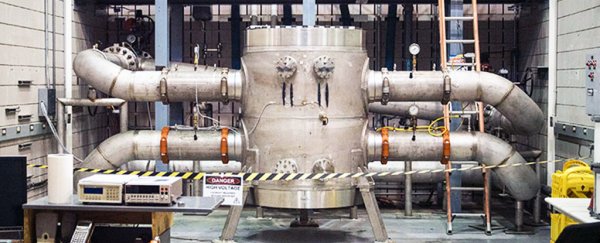The pulling power of the world's strongest resistive magnet now stands at 41.4 teslas, thanks to the efforts of scientists at the National High Magnetic Field Laboratory (or MagLab), part of Florida State University.
Taking two-and-a-half years and $3.5 million in funding to build, the magnet smashed the previous record of 38.5 teslas earlier this week.
And the new high watermark in magnetic strength is about more than just bragging rights: these super-powerful magnets help researchers in the fields of medical research, chemical reactions, and even quantum computing.
The record-breaker is codenamed Project 11, after the "turn it up to 11" phrase from the film This Is Spinal Tap – it means going beyond the usual limit of 10 to something beyond.
 Credit: National High Magnetic Field Laboratory
Credit: National High Magnetic Field Laboratory
"With the Project 11 magnet, we asked our engineers to turn it up a notch and see what they could accomplish," says MagLab director Greg Boebinger.
"This new brute delivers and will enable scientists to make discoveries that lead to better materials and technologies and deepen our understanding of how our world works."
Resistive magnets, unlike the ones you might stick on your fridge, work when electric currents are applied, and this one required 32 megawatts of DC power – enough to get around 21,500 kettles up to boiling point.
And how strong is 41.4 teslas? Going back to the fridge magnets, you'd need more than 4,000 of them to achieve the same force.
MagLab is home to many other types of magnet, including a 21-tesla superconducting magnet (also an electromagnet, and the type often used in MRI scanners) and a 45-tesla hybrid magnet (which combines the properties of resistive and superconducting magnets for something even stronger).
Resistive magnets like the new record-breaker at MagLab are formed from stacks of copper conductors and insulating material, put together in a helical structure. When the voltage hits, current flows through in a helix pattern to create a strong magnetic field in the centre.
The record was achieved by introduced tweaks to the design to improve electrical current density and repurposing parts from old magnets to keep costs down.
"This larger magnet allows us to use 50 percent more coils," says Project 11 magnet designer Jack Toth. "That enabled power to be distributed more efficiently within the magnet and reach a new record with the same materials."
While hybrid magnets can create stronger magnetic fields, resistive magnets are easier for scientists to make use of, and this one will be made available to scientists and researchers in the coming months.
The magnet is housed at the DC Field Facility, and its director Tim Murphy says the record-breaking magnet will prove its worth in the years to come.
"It's about providing the scientific community access to high fields," says Murphy. "That's why we're here."
